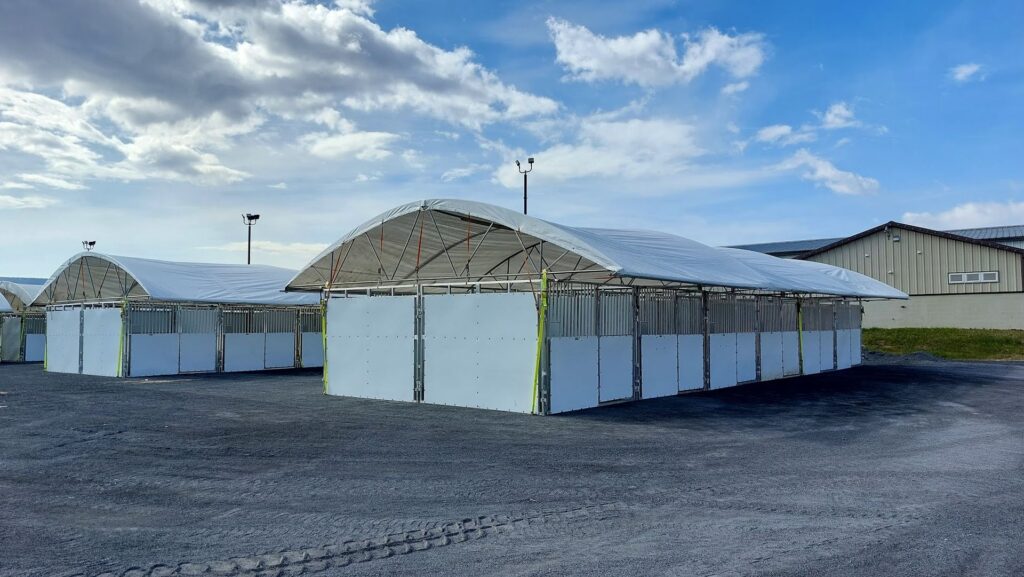In recent years, the construction industry has witnessed a significant paradigm shift towards sustainability, underscoring the urgent need to minimize environmental footprints across all sectors. This movement is particularly resonant within the equine sector, where the demand for eco-friendly solutions has paved the way for innovative approaches to building equine facilities. Among these innovations, the development and use of portable horse stalls stand out as a prime example of how the industry is responding to the call for more sustainable construction practices. These adaptable structures not only offer a practical solution for horse owners in Delaware and facilities but also embody the commitment to preserving our planet for future generations.
Sustainable Materials in Equine Construction in Delaware
Recycled steel, known for its durability and strength, has become a cornerstone in the development of these stalls, offering a way to repurpose materials that might otherwise contribute to landfill waste. Similarly, sustainably sourced wood provides an eco-friendly alternative, ensuring that the timber used in stall construction comes from responsibly managed forests.
The benefits of utilizing these sustainable materials extend far beyond their minimal environmental impact. For the horses, these materials ensure a safer and healthier living environment, free from the harmful chemicals often associated with conventional construction materials. Furthermore, the thermal properties of sustainable materials like wood can offer better insulation, creating a more comfortable and stress-free habitat for the animals.
Energy Efficiency and Construction Practices
The push for energy efficiency in the construction of equine facilities is driving significant advancements in how these structures are designed and built. Architects and builders are increasingly adopting green building practices that reduce the environmental footprint of equine facilities and translate into considerable cost savings for facility owners over time. One of the key areas of focus is the optimization of natural light and ventilation, lowering energy consumption. Additionally, the use of energy-efficient lighting and appliances further diminishes the overall energy demand of these facilities.
Insulation is crucial in energy efficiency, with materials being selected for their ability to maintain stable indoor temperatures, reducing the need for heating during winter and cooling in the summer. This not only makes the barns more comfortable for the horses but also significantly cuts down energy costs. Moreover, the adoption of smart building technologies, such as automated lighting systems and energy management software, allows for more precise control over energy use, ensuring that resources are utilized only when necessary. These practices contribute to a substantial reduction in the carbon footprint of equine facilities while ensuring long-term sustainability and financial viability.
Innovations Enhancing Sustainability
As the equine industry embraces sustainability, more and more innovative construction methods, such as 3D printing a horse barn, are starting to emerge, offering new ways to build more efficiently and with less waste. This technique allows for precise control over material use and can create complex structures that traditional methods cannot, often with reduced material requirements and shorter construction times.
Beyond 3D printing, the industry is seeing the adoption of other cutting-edge technologies aimed at enhancing sustainability. Solar-powered lighting systems are increasingly common in portable horse stalls, providing a renewable source of energy that can significantly reduce electricity use. Similarly, rainwater harvesting systems capture and repurpose rainwater for various uses within the facility, such as watering horses or cleaning, thereby conserving freshwater resources.
Benefits of Portable Horse Stalls in Delaware
From a sustainability perspective, portable horse stalls offer several distinct advantages that align with the goals of reducing environmental impact, enhancing versatility, and ensuring adaptability to diverse settings. The very nature of these stalls means they can be easily assembled, disassembled, and relocated, minimizing the need for permanent structures and the resources they consume. This portability significantly reduces the environmental footprint associated with constructing new facilities, as it allows for the reuse of materials and stalls in multiple locations over their lifetime.
Moreover, the flexibility of portable horse stalls means they can be adapted to various environmental conditions and settings, from outdoor events to temporary accommodations in response to seasonal needs. This adaptability not only extends the utility of each stall but also contributes to a more efficient use of resources, as the same structure can serve multiple purposes. Additionally, the ability to transport these stalls directly to where they are needed reduces transportation emissions associated with moving horses to permanent facilities.
In Conclusion
The construction of equine facilities in Delaware is undergoing a transformative shift towards sustainability, driven by the adoption of innovative materials, energy-efficient designs, and cutting-edge technologies like solar-powered lighting and rainwater harvesting systems. Portable horse stalls stand at the forefront of this movement, exemplifying how adaptability and efficiency can go hand in hand with environmental stewardship. As the equine and construction communities continue to embrace these sustainable practices, they pave the way for a greener future. By prioritizing sustainability in every aspect of equine facility construction, we can ensure the well-being of our horses while preserving the planet for generations to come.

